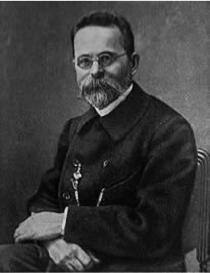


Polymath N. A. Morozov, whose writings became a foundation stone for all followers of alternative history and new chronology, had his own view on Tischendorf's activities. Tischendorf brought a manuscript with Bible text from Sinai and published it in 1862 as if it dated from the 4th century. Morozov believed that Tischendorf deliberately passed the manuscript to the Russian library, far from all cultural centres and almost unreachable for European scholars at the time so they had no means to expose his plot. In 1932 he was named an Honorary Member of the Soviet Academy of Sciences. The next year, Russia sold the Codex Sinaiticus to Britain. Morozov may have influenced the decision to sell the manuscript, which he believed to be much younger than it was reported to be.
Morozov examined the Sinaiticus personally and saw the following:
"lower corners of the parchment sheets of the document are not frayed at all, bear no traces of greasiness and finger prints as it should have had the manuscript been in usage for centuries during church service by Sinai monks, who had never been remarkable for their cleanliness like all Eastern monks though…
At the same time while inner parchment sheets of the manuscript are utterly new (meaning with no defects and greasiness) all front and rear cover sheets are torn and even lost… The most interesting fact about the Sinaiticus is the condition of its inner parchment. The sheets are very thin, made of elaborate leather and, that is the most peculiar, are very flexible, non-fragile at all! And this circumstance is rather important for dating the manuscript.
When we are dealing with ancient documents which were kept for milleniums even in the best climate conditions we see that even the slightest touch can turn them into dust as if we touch ash of the book that invisibly smoldered affected by oxygen. Perfect state of Sinaiticus inner sheets while its torn covers shows that monks treated the manuscript with neglect suggests that the manuscript was presented to the monastery by some pious lover of old religion patterns when new patterns were already in use that is after X century. It was not damaged inside by constant reading possibly because monks became unaccustomed to such writing and preferred to read new patterns. Only due to this fact the manuscript had been preserved on Sinai till the time it was found by Tischedorf."
Morozov N.A. Proroki. Istoriya vozniknoveniya bibleyskih prorochestv, ih literaturnoe izlozhenie i characteristiki. Moscow, 1914.
Morozov examined the Sinaiticus personally and saw the following:
"lower corners of the parchment sheets of the document are not frayed at all, bear no traces of greasiness and finger prints as it should have had the manuscript been in usage for centuries during church service by Sinai monks, who had never been remarkable for their cleanliness like all Eastern monks though…
At the same time while inner parchment sheets of the manuscript are utterly new (meaning with no defects and greasiness) all front and rear cover sheets are torn and even lost… The most interesting fact about the Sinaiticus is the condition of its inner parchment. The sheets are very thin, made of elaborate leather and, that is the most peculiar, are very flexible, non-fragile at all! And this circumstance is rather important for dating the manuscript.
When we are dealing with ancient documents which were kept for milleniums even in the best climate conditions we see that even the slightest touch can turn them into dust as if we touch ash of the book that invisibly smoldered affected by oxygen. Perfect state of Sinaiticus inner sheets while its torn covers shows that monks treated the manuscript with neglect suggests that the manuscript was presented to the monastery by some pious lover of old religion patterns when new patterns were already in use that is after X century. It was not damaged inside by constant reading possibly because monks became unaccustomed to such writing and preferred to read new patterns. Only due to this fact the manuscript had been preserved on Sinai till the time it was found by Tischedorf."
Morozov N.A. Proroki. Istoriya vozniknoveniya bibleyskih prorochestv, ih literaturnoe izlozhenie i characteristiki. Moscow, 1914.



"Sinaiticus parchment sheets are very flexible as I have already said, by this simple material examination it can't be dated earlier than 600 years from this date."
Nikolai Alexandrovich Morozov, 1914 (translation from Russian)
Page 260,
Prophets. Genesis of biblical prophesies, its literary presentation and characteristics.
(available for purchase via Google Books)
Page 260,
Prophets. Genesis of biblical prophesies, its literary presentation and characteristics.
(available for purchase via Google Books)











